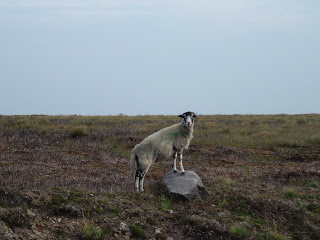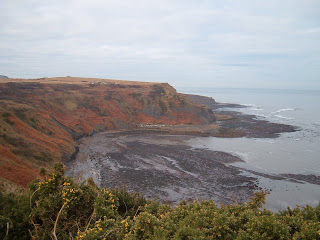Off to find the Anglo-Saxons

I’m going on a trip. This means that later today I will stand in the middle of my bedroom, and have a small, but intense, hissy-fit. I will be surrounded by raincoats, pants, sweaters, jackets, scarves, shoes – LOTS of shoes – jeans, dress pants, pajamas, t-shirts, sweatshirts, socks, and underpants. I will have open suitcases on the bed and on the floor. I will have an odd assortment of small plastic bottles in which to carry face cream, toner, soap, eye cream, body lotion, toothpaste, etc., not to mention all those vitamin pills, research papers, notebooks, and the half-dozen copies of my books that various people have asked for.
In short, I will be attempting to fit far too much stuff, most of which I won’t use, into far too-little space. By four o’clock I will be convinced I look terrible in every piece of clothing I own, and although I will spend hours trying to figure out what I will want to wear in two weeks, when two weeks comes, I will find I have been wrong. I will also forget something crucial, probably.
I hate packing. No, I mean it. I really hate it. To spend hours focused on clothes and trying to predict future weather patterns and social requirements gives me mind-cramps and often reduces me to tears.
I haven’t started packing, of course. Like the homework I used to loathe in fifth grade, I’ve left it to the last minute. What I have done is bought a new raincoat, a new blazer, a new pair of pants, and three new sweaters. Why? Because I always think new clothes will make me feel better about the process. They won’t.
I remember our family cocker spaniel when I was a little girl. Bambi. (Yes, I KNOW.) As soon as my mother (who started packing for a trip at least a week before we were scheduled to leave), took the first suitcase off the top shelf of the linen closet, the poor dog would collapse into a doggy-funk of depression punctuated by huge jowl-flapping sighs, those pathetic expressions only dogs with long ears and limpid brown eyes can manage, and a general malaise that lasted until we returned – when she morphed into a running-jag, sober-mouthed, full-body wagging ecstasy machine. That’s kind of what I’m like, only without the long ears and slobbering, I hope.
Apart from the clothes issue, which is bad enough, the other thing I must decide, on this whirlwind tour of nine or ten towns (all important to the 7th century period I’m researching. Madness.) is what books to bring? How I envy those people who are satisfied with watching downloaded movies on their iPods. Such a tiny space. So lightweight. Snort.
Okay, so here’s the list I’ve come up with this morning – trying to take into account the overseas flight, several initial days in Zurich, Switzerland, where my husband has business and I have nothing whatsoever to do except get over my hideous jet-lag. (At present I’m reading Zoli, by Colm McCann, which is wonderful, but it’s hardcover and I try never to bring large hardcover books with me when traveling, since they don’t fit into even my huge purse.)
The King Must Die by Mary Renault. Renault is considered one of the great historical novelists and I’d like to see how she handles the legendary hero Theseus.
The Hungering Dark, by Frederick Buechner. This book of reflections on biblical themes what given to me by a Quaker friend, Marcia Willsie. The first place to which I opened the book (p. 53) said, “Who knows what the facts of Jesus’ birth actually were?…The longer I live the more inclined I am to believe in miracle…but of course that is not the point, because the Gospel writers are not really interested primarily in the facts of the birth but in the significance.” That bodes well.
The Master of Petersburg, by J.M. Coetzee, wherein Coetzee imagines the life of Dostoevsky. I’ve been meaning to read this for a long time.
Christ of the Celts, by J. Philip Newell. Newell, one of the great Celtic theologians, explores the Celtic image of Christ as “the Memory of what we have forgotten. He remembers the dance of the universe and the harmony that is deep within all things. He is the Memory also of who we are.” I love New
ell, and I know his work will inform this new novel.
Selected Writing of Anglo-Saxon Spirituality. An anthology of sermons, homilies and poems written during the later part of their age (c. 660-1066). Although the period I’m writing about (612 to 657, roughly) only squeaks in here, the ideology, theology and literary style are intertwined.
The Heliand.Translated by G. Ronald Murphy, S.J. This is the Saxon Gospel, the life and deeds of Jesus retold, in 9th century, in the style of Beowulf. Bethlehem becomes a hill-fort, horses and horse-guards replace sheep and shepherds, prophets are soothsayers, and the apostles are household warriors. Christ is the greatest of chieftains – the Chieftain of Mankind. Great stuff, and I hope it will give me insight into how the pagan Anglo-Saxons converted to Christianity. What’s the common ground between these two apparently disparate world-views?
The Saxon Savior. G. Ronald Murphy, S.J. – Murphy’s interpretive companion work to The Heliad.
So, we shall see how many of these I actually get through. And I’ll keep you posted both on my reading progress and what I experience on the road – with the help of Ron’s fabulous photos, I hope. I’ll travel from Sutton Hoo (the great Anglo-Saxon burial site) to West Stow in Bury St. Edmunds where there’s an Anglo-Saxon recreation village, to York, to Whitby, to Hartlepool, to Jarrow, to Bamburgh, to Yeavering in the Chevriot Hills, to the Holy Island Lindisfarne and finally to Edinburgh. Hopefully we can fit in a day of two of rambling about the moors. Much tea will be drunk. 
All right. Enough procrastination. To the luggage!!!
Copyright 2008 Lauren B. Davis For permissions: laurenbdavis.iCopyright.com